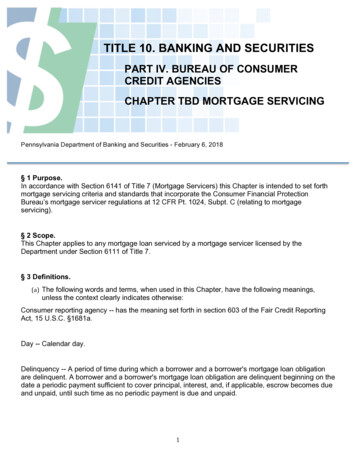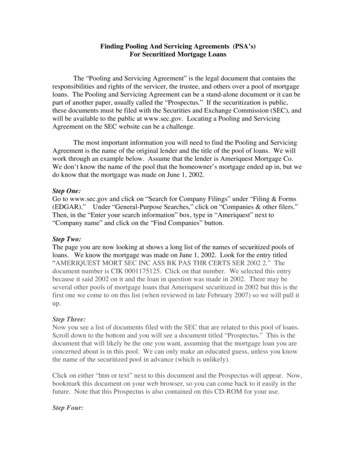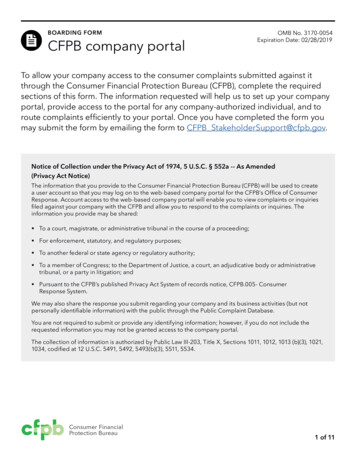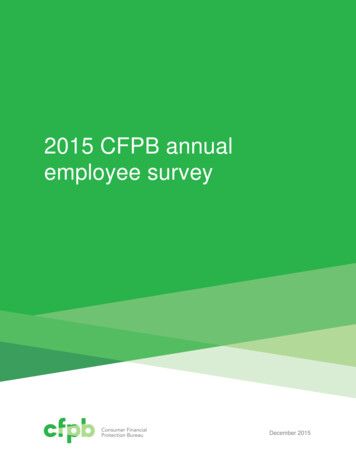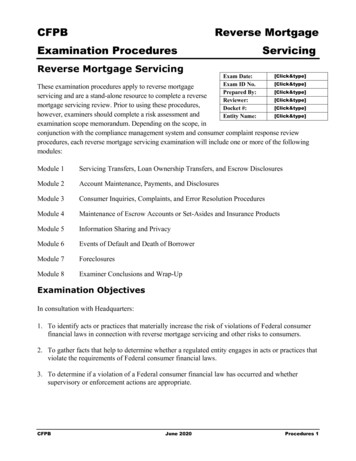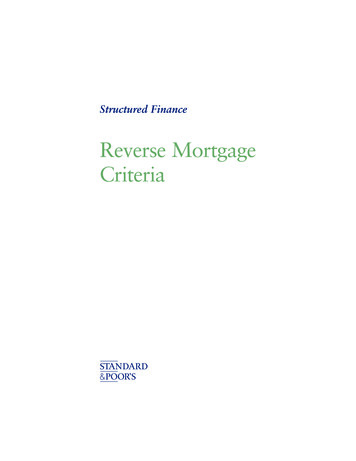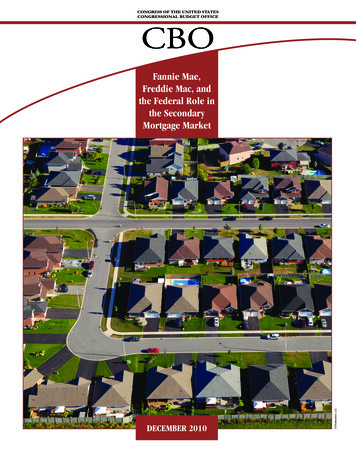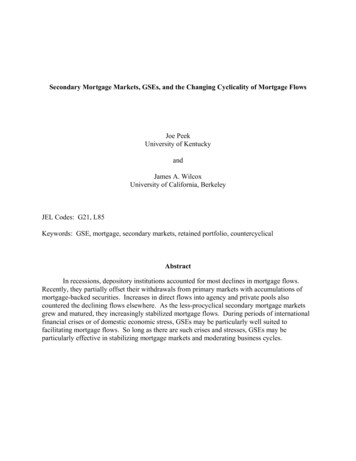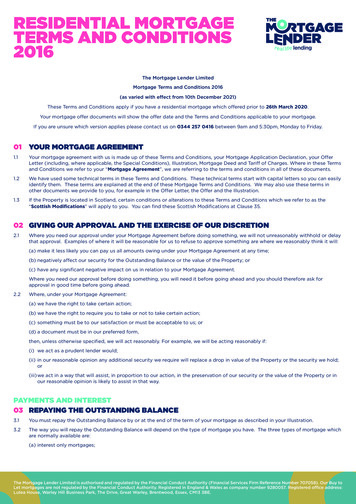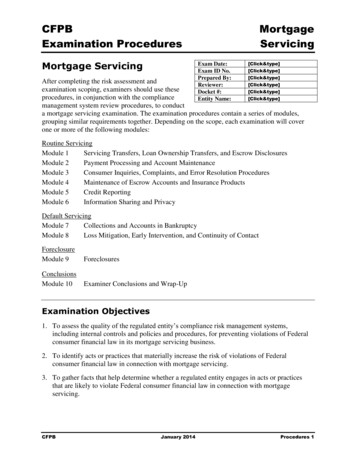
Transcription
CFPBExamination ProceduresMortgage ServicingMortgageServicingExam Date:Exam ID No.Prepared By:Reviewer:Docket #:Entity pe][Click&type][Click&type]After completing the risk assessment andexamination scoping, examiners should use theseprocedures, in conjunction with the compliancemanagement system review procedures, to conducta mortgage servicing examination. The examination procedures contain a series of modules,grouping similar requirements together. Depending on the scope, each examination will coverone or more of the following modules:Routine ServicingModule 1Servicing Transfers, Loan Ownership Transfers, and Escrow DisclosuresModule 2Payment Processing and Account MaintenanceModule 3Consumer Inquiries, Complaints, and Error Resolution ProceduresModule 4Maintenance of Escrow Accounts and Insurance ProductsModule 5Credit ReportingModule 6Information Sharing and PrivacyDefault ServicingModule 7Collections and Accounts in BankruptcyModule 8Loss Mitigation, Early Intervention, and Continuity of ContactForeclosureModule 9ForeclosuresConclusionsModule 10Examiner Conclusions and Wrap-UpExamination Objectives1. To assess the quality of the regulated entity’s compliance risk management systems,including internal controls and policies and procedures, for preventing violations of Federalconsumer financial law in its mortgage servicing business.2. To identify acts or practices that materially increase the risk of violations of Federalconsumer financial law in connection with mortgage servicing.3. To gather facts that help determine whether a regulated entity engages in acts or practicesthat are likely to violate Federal consumer financial law in connection with mortgageservicing.CFPBJanuary 2014Procedures 1
CFPBExamination ProceduresMortgageServicing4. To determine, in consultation with Headquarters, whether a violation of a Federal consumerfinancial law has occurred and whether further supervisory or enforcement actions areappropriate.BackgroundA servicer may service loans on behalf of itself or an affiliate. It may service as a contractor ofthe trustee where a mortgage is included in a mortgage-backed security, or it may service wholeloans for an outside third-party investor.1 A servicer may sell the rights to service the loanseparately from any ownership transfers. This is because some entities have expertise in paymentprocessing and other servicing responsibilities, while others seek to invest in the underlyingmortgages. These procedures apply whether the servicer obtained the servicing rights fromanother entity or the servicing responsibility is transferred within a company from the originationplatform to the servicing platform.Servicers must comply with various laws to the extent that the law applies to the particularservicer and its activities: The Real Estate Settlement Procedures Act (RESPA) and its implementing regulation,Regulation X, impose requirements for servicing transfers, written consumer informationrequests, resolution of notices of error, force-placed insurance, early intervention andcontinuity of contact for delinquent borrowers, loss mitigation procedures, general servicingpolicies and procedures, and escrow account maintenance. The Truth in Lending Act (TILA) and its implementing regulation, Regulation Z, imposerequirements on servicers regarding periodic billing statements, crediting of payments,imposition of late fee and delinquency charges, provision of payoff statements with respect toclosed-end consumer credit transactions secured by a principal dwelling, and disclosuresregarding rate changes for adjustable rate mortgages. For open-end mortgages, Regulation Zprovisions related to payment crediting and error resolution apply to the extent that theservicer is a creditor. Additionally, TILA and Regulation Z generally impose requirementson loan owners for loan ownership transfers. The Electronic Funds Transfer Act (EFTA) and its implementing regulation, Regulation E,impose requirements if servicers within the scope of coverage obtain electronic paymentsfrom borrowers. The Fair Debt Collection Practices Act (FDCPA) governs collection activities conducted bythird-party collection agencies, as well as servicer collection activities if the servicer acquiredthe loan when it was already in default.1If the owner is a separate entity, the servicer generally has contractual commitments to the owner of the loan. In the privatesecuritization market, the contracts generally are called Pooling and Servicing Agreements or PSAs. If a Fannie Mae or FreddieMac owns the loan, the commitments are set forth in the company’s seller/servicer guides.CFPBJanuary 2014Procedures 2
CFPBExamination ProceduresMortgageServicing The Homeowners Protection Act (HPA) limits private mortgage insurance that can beassessed on consumer accounts. The Fair Credit Reporting Act (FCRA) requires servicers that furnish information toconsumer reporting agencies to ensure the accuracy of data placed in the consumer reportingsystem. The FCRA also limits certain information sharing between company affiliates. The Gramm-Leach-Bliley Act (GLBA) requires servicers within the scope of coverage toprovide privacy notices and limit information sharing in particular ways. The Equal Credit Opportunity Act (ECOA) and its implementing regulation, Regulation B,apply to those servicers that are creditors, such as those who participate in a credit decisionabout whether to approve a mortgage loan modification. The statute makes it unlawful todiscriminate against any borrower with respect to any aspect of a credit transaction:o On the basis of race, color, religion, national origin, sex or marital status, or age(provided the applicant has the capacity to contract);o Because all or part of the applicant’s income derives from any public assistance program; oro Because the applicant has in good faith exercised any right under the Consumer CreditProtection Act.2To carry out the objectives set forth in the Examination Objectives section, the examinationprocess also will include assessing other risks to consumers that are not governed by specificstatutory or regulatory provisions. These risks may include potentially unfair, deceptive, orabusive acts or practices (UDAAPs) with respect to servicers’ interactions with consumers.3Collecting information about risks to consumers, whether or not there are specific legalguidelines addressing such risks, can help inform the Bureau’s policymaking. The standards theCFPB will use in assessing UDAAPs are:oA representation, omission, act, or practice is deceptive when:(1) the representation, omission, act, or practice misleads or is likely to mislead theconsumer;(2) the consumer’s interpretation of the representation, omission, act, or practice isreasonable under the circumstances; and(3) the misleading representation, omission, act, or practice is material.2The Consumer Credit Protection Act, 15 U.S.C. 1601 et seq., is the collection of federal statutes that protects consumers whenapplying for or receiving credit. The Act includes statutes that have dispute rights for consumers, such as the Fair CreditReporting Act. The ECOA prohibits discriminating against an applicant who has exercised a dispute right pursuant to one of thestatutes outlined in the Act.3Dodd-Frank Act, Sec. 1036, PL 111-203 (July 21, 2010).CFPBJanuary 2014Procedures 3
CFPBExamination ProceduresMortgageServicingo An act or practice is unfair when:(1) it causes or is likely to cause substantial injury to consumers;(2) the injury is not reasonably avoidable by consumers; and(3) the injury is not outweighed by countervailing benefits to consumers or tocompetition.o An abusive act or practice:(1) materially interferes with the ability of a consumer to understand a term or conditionof a consumer financial product or service or(2) takes unreasonable advantage of – a lack of understanding on the part of the consumer of the material risks, costs, orconditions of the product or service; the inability of the consumer to protect its interests in selecting or using aconsumer financial product or service; or the reasonable reliance by the consumer on a covered person to act in the interestsof the consumer.Please refer to the examination procedures regarding UDAAPs for more information about thelegal standards and the CFPB’s approach to examining for UDAAPs.The particular facts in a case are crucial to a determination of unfair, deceptive, or abusive actsor practices. As set out in the Examination Objectives section, examiners should consult withHeadquarters to determine whether the applicable legal standards have been met before aviolation of any federal consumer financial law could be cited, including a UDAAP violation.CFPBJanuary 2014Procedures 4
CFPBExamination ProceduresMortgageServicingModule 1 – Servicing Transfers, Loan OwnershipTransfers, and Escrow DisclosuresServicing TransfersExaminers should engage in several steps to assess potential violations of law in connection withservicing transfers, loan ownership transfers, and escrow disclosures. First, examiners shouldreview a sample of servicing records, from the servicer’s primary computer system, for loanstransferred within the previous year. Examiners also may need to review copies of the electronicand paper documents transferred from the prior servicer. Additionally, they should review relevantrecords outside the servicer’s primary computer system, such as copies of monthly statements sentto consumers, copies of the RESPA disclosures, and evidence of delivery. If consumer complaintsor document review indicate potential violations in these areas, examiners also may conductinterviews of consumers from the sample and ask questions relevant to each topic area below.RESPA1. Assess compliance with RESPA provisions regarding Mortgage Servicing TransferDisclosures and General Servicing Policies, Procedures and Requirements. Please referto the examination procedures regarding RESPA, 12 CFR 1024.33 and 1024.38(a) &(b)(4), for more information.[Click&type]FDCPA2. Assess compliance with FDCPA, Right to Validation Notice for Certain Consumers.Please refer to the examination procedures regarding FDCPA, 15 U.S.C. 1692g (a), formore information.[Click&type]Other Risks to Consumers3. Determine whether the servicer takes steps to facilitate the transfer of the consumer’sautomated clearing house (ACH) payments in connection with the transfer of servicingrights. For example, determine whether the servicer takes steps, including makingdisclosures, so that consumers do not inadvertently fail to make a timely mortgagepayment or make a double mortgage payment following the transfer.[Click&type]4. Determine whether a servicer who receives servicing transfers complies with the terms ofloss mitigation agreements entered into by the borrower and the prior servicer.[Click&type]CFPBJanuary 2014Procedures 5
CFPBExamination ProceduresMortgageServicingOwnership TransferRegulation ZExaminers should determine whether the servicer is required to transmit the loan ownershiptransfer notice. The institution would have this obligation if (a) it owns any of the loans in theservicing portfolio and (b) the loan is secured by the principal dwelling of the consumer.(12 CFR 1026.39(a)(1)).4To assess whether the servicer is complying with obligations under Regulation Z to notifyconsumers of changes in the loan ownership, examiners should sample from the list of loans inwhich the loan’s owner changed within the previous year. For the loans in the sample,examiners should review copies of consumer disclosures regarding loan ownership andevidence of delivery.5. Assess compliance with Regulation Z, Notice of Ownership Transfer Provision. Pleaserefer to the examination procedures regarding Regulation Z, 12 CFR 1026.39, for moreinformation.[Click&type]Escrow TransfersRESPATo assess whether the servicer is complying with obligations under Regulation X to notifyconsumers of changes in the escrow account requirements resulting from a transfer of servicing,examiners should sample from the list of loans transferred within the previous year that includedescrow accounts. For the loans in the sample, examiners should review copies of consumerdisclosures regarding the escrow accounts and evidence of delivery.6. Assess compliance with RESPA, Escrow Accounts, Transfer of Servicing Provisions.Please refer to the examination procedures regarding RESPA, 12 CFR 1024.17(e), formore information.[Click&type]4A servicer of a mortgage loan is not treated as an owner of the obligation if the servicer holds title to the loans, ortitle is assigned to the servicer, solely for the administrative convenience of the servicer in servicing the obligation.Contractually, the loan owner may have delegated the Regulation Z obligation to the servicer. Although the loanowner cannot delegate its obligation under law, examiners should assess whether the servicer is fulfilling itscommitment, if applicable.CFPBJanuary 2014Procedures 6
CFPBExamination ProceduresMortgageServicingModule 2 – Payment Processing and AccountMaintenanceTo assess payment posting and fee practices, examiners should review a sample of servicingrecords. Examiners should begin by reviewing a sample of records from the servicer’s primaryrecord system; if potential problems are found, examiners should review copies of relevantrecords outside the primary system, such as copies of monthly statements, copies of consumerpayment records, and copies of bills from vendors documenting any services related to theconsumer’s loan account. If consumer complaints or document review indicates potentialviolations in these areas, examiners also may conduct interviews of consumers from the sampleand ask questions relevant to each topic area below.Payment ProcessingRegulation Z1. Assess compliance with Regulation Z, Payment Posting Provisions for closed-endmortgages secured by a consumer’s principal dwelling. Please refer to theexamination procedures regarding Regulation Z, 12 CFR 1026.36(c)(1), for moreinformation.[Click&type]2. Assess compliance with Regulation Z, Payment Posting Provisions for open-endmortgages. Please refer to the examination procedures regarding Regulation Z, 12 CFR1026.10, for more information.[Click&type]Optional ProductsECOA3. Determine whether the servicer offers debt cancellation, debt suspension, or othersimilar additional products or services and, if so, which products and/or services theservicer offers.[Click&type]4. Determine whether each such optional product or service is offered and provided in amanner consistent with ECOA. Targeted marketing of these products on the basis ofrace, for example, may indicate an increased risk of potential ECOA violations andrequire further inquiry. In consultation with Headquarters, assess whether marketingis targeted on such a basis to particular consumers or in particular areas.[Click&type]CFPBJanuary 2014Procedures 7
CFPBExamination ProceduresMortgageServicingOther Risks to Consumers5. Determine whether the servicer offers additional products or services (such as biweekly payment plans, payment protection or credit protection) and, if so, whichproducts and/or services the servicer offers.[Click&type]6. Review marketing materials, whether they are telemarketing scripts, direct mail, webbased, or other media, and determine whether each optional product’s costs and termsare clearly and prominently disclosed. If consumer complaints or document reviewindicates potential violations in these areas and the servicer engages in telemarketing,monitor call center activity, and statements of representatives marketing the products.If the servicer engages in web-based marketing, monitor Internet communicationsrelated to the marketing.[Click&type]7. Determine whether the servicer added on optional products or services withoutobtaining explicit authorization from the consumer. If the servicer obtains writtenauthorization, review records of consumers who received additional products orservices to ensure that written authorization has been provided and retained.[Click&type]8. For bi-weekly payment plan solicitations, determine whether the servicer clearly andconspicuously explains the terms and conditions, including, where applicable,whether the servicer will be crediting payments bi-weekly or only monthly.[Click&type]9. In assessing risks to consumers, examiners may find evidence of violations of—or anabsence of compliance policies and procedures with respect to—other laws, in whichcase examiners should identify such matters for appropriate actions, such as, whereauthorized, possible referral to other regulators. For example, the ServicemembersCivil Relief Act requires a servicer to reduce the interest rate that a servicemembermust pay on private and federal student loans to 6 percent upon receiving a writtenrequest and a copy of the servicemember’s military orders calling them into militaryservice. The servicer must reduce the servicemember’s interest rate to 6 percentwhen: The loan is a pre-service obligation – entered into prior to the borrowerentering military service; The borrower has submitted a written request to the servicer; and The borrower has provided a copy of their military orders to the servicer.[Click&type]CFPBJanuary 2014Procedures 8
CFPBExamination ProceduresMortgageServicingPeriodic Statements and Other DisclosuresExaminers must review the servicer’s policies, procedures, and systems to assess the adequacy ofperiodic statements and whether applicable disclosures are furnished when required byRegulation Z. Examiners also should review a sample of periodic statements.Regulation ZPeriodic Statements9. Assess compliance with Regulation Z, Periodic Statements for Open End Mortgages.Please refer to the examination procedures regarding Regulation Z, 12 CFR 1026.7,for more information.[Click&type]10. Assess compliance with Regulation Z, Periodic Statements for Closed-EndMortgages. Please refer to the examination procedures regarding Regulation Z, 12CFR 1026.41, for more information.[Click&type]11. Assess compliance with Regulation Z, Periodic Statements for Home Equity Plans.Please refer to the examination procedures regarding Regulation Z, 12 CFR 1026.40,for more information.[Click&type]Adjustable Rate Mortgage Disclosures12. Assess compliance with Regulation Z, Disclosure of Initial Rate Change forAdjustable Rate Mortgages. Please refer to the examination procedures regardingRegulation Z, 12 CFR 1026.20(d), for more information.[Click&type]13. Assess compliance with Regulation Z, Disclosure of Rate Adjustments Resulting inPayment Changes. Please refer to the examination procedures regardingRegulation Z, 12 CFR 1026.20(c), for more information.[Click&type]EFTA14. If the servicer is within the scope of coverage and obtains electronic payments fromborrowers, assess compliance with EFTA’s requirements for handling authorizationsfor electronic payments from consumers. Please refer to the examination proceduresregarding EFTA’s provisions on pre-authorized electronic transfers, 12 CFR 1005, formore information.[Click&type]CFPBJanuary 2014Procedures 9
CFPBExamination ProceduresMortgageServicingPayoff StatementsRegulation Z – Payoff Statements15. Assess compliance with Regulation Z, Providing Payoff Statements. Please refer tothe examination procedures regarding Regulation Z, 12 CFR 1026.36(c)(3), formore information.[Click&type]Other Risks to Consumers – Payoff Statements16. Determine whether, when calculating the payoff amount, the servicer includes latecharges and fees owed in the payoff amount or instead deducts such fees and chargesfrom the escrow account.[Click&type]Treatment of Credit BalancesRegulation Z – Treatment of Credit Balances17. Assess compliance with Regulation Z, Treatment of Credit Balances. Please refer tothe regulation and examination narrative and procedures regarding Regulation Z,12 CFR 1026.11 and 1026.21, for more information.[Click&type]Treatment of Private Mortgage InsuranceHomeowners’ Protection Act of 199818. Assess compliance with Homeowners’ Protection Act. Please refer to theexamination procedures regarding the HPA, 12 U.S.C. 4902 and 4903(a)(3), for moreinformation.[Click&type]Record Retention and Servicing FileRESPA19. Assess compliance with Regulation X, Record Retention. Please refer to theexamination procedures regarding Regulation X, 12 CFR 1024.38(c)(1), for moreinformation.[Click&type]20. Assess compliance with Regulation X, Servicing File. Please refer to the examinationprocedures regarding Regulation X, 12 CFR 1024.38(c)(2), for more information.[Click&type]CFPBJanuary 2014Procedures 10
CFPBExamination ProceduresMortgageServicingModule 3 – Consumer Inquiries, Complaints andError Resolution ProceduresExaminers should review consumer complaints and call specific complaining consumers tointerview them regarding their experiences. Examiners should listen to live calls and taped callsto assess the quality and training of call center personnel. Examiners should determine whethertheir complaints were resolved adequately, and whether they were resolved in a timely manner.RESPAError Resolution Procedures1. Assess compliance with Regulation X, Notice of Error Provision. Please refer to theexamination procedures regarding Regulation X, 12 CFR 1024.35, for more information.[Click&type]Requests for Information2. Assess compliance with Regulation X, Written Information Request Provision. Pleaserefer to the examination procedures regarding Regulation X, 12 CFR 1024.36, for moreinformation.[Click&type]Policies and Procedures3. Assess compliance with Regulation X’s requirement to maintain policies and proceduresthat are reasonably designed to achieve the objective of informing borrowers of thewritten error resolution and information request procedures. Please refer to theexamination procedures regarding Regulation X, 12 CFR 1024.38(b)(5), for moreinformation.[Click&type]4. Assess compliance with Regulation X’s requirement to maintain policies and proceduresthat are reasonably designed to achieve the objective of accessing and providing timelyand accurate information. Please refer to the examination procedures regardingRegulation X, 12 CFR 1024.38(b)(1), for more information.[Click&type]Open-End Mortgages – Billing Errors5. Assess compliance with Regulation Z, Open-End Credit, Billing Errors Procedures.Please refer to the examination procedures regarding Regulation Z, 12 CFR 1026.13, formore information.[Click&type]CFPBJanuary 2014Procedures 11
CFPBExamination ProceduresMortgageServicingModule 4 – Maintenance of Escrow Accounts andInsurance ProductsMaintenance of EscrowExaminers should obtain a sample of servicing records. For the loans in the sample, examinersshould assess whether the servicer is complying with the law in the areas listed below. If the filereview indicates potential risks, examiners also should conduct interviews of a sample ofconsumers and staff, if appropriate, to assess consumer experiences with escrow accounts andany force-placed insurance products.Escrow Disclosures1. Assess compliance with Regulation X, Escrow Disclosures. Please refer to theexamination procedures regarding Regulation X, 12 CFR 1024.17, for more information.[Click&type]Force-Placed Insurance2. Assess compliance with Regulation X, Timely Payments. Please refer to the examinationprocedures regarding Regulation X, 12 CFR 1024.17(k)(5), for more information.[Click&type]3. Assess compliance with Regulation X, Force-Placed Insurance Provision. Please refer tothe examination procedures regarding Regulation X, 12 CFR 1024.37, for moreinformation.[Click&type]CFPBJanuary 2014Procedures 12
CFPBExamination ProceduresMortgageServicingModule 5 – Credit ReportingExaminers should obtain a sample of loan servicing records. For the loans in the sample,compare the information in the servicer’s system of record with the information reported to thecredit reporting agencies. Particular concerns in the mortgage servicing context include ensuringthat servicers report short sales accurately, instead of reporting transactions as resulting in aforeclosure when they actually resulted in a short sale, and ensuring that servicers report loanmodification outcomes accurately. If consumer complaints or document review indicatespotential FCRA violations, examiners also may conduct interviews of consumers from thesample.FCRA Furnisher Requirements1. Assess compliance with FCRA Furnisher Requirements. Please refer to the FCRAexamination procedures, 12 CFR 1022.40-43, for more information.[Click&type]CFPBJanuary 2014Procedures 13
CFPBExamination ProceduresMortgageServicingModule 6 – Information Sharing and PrivacyPrivacy Notices1. Assess compliance with Privacy of Consumer Financial Information Regulation thatimplements the GLBA. Please refer to the GLBA examination procedures, 12 CFR1016.4 and 1016.5, for more information.[Click&type]Information Sharing With Affiliates2. Assess compliance with the FCRA Affiliate Marketing Rule. Please refer to the FCRAexamination procedures, 12 CFR 1022.21, for more information.[Click&type]CFPBJanuary 2014Procedures 14
CFPBExamination ProceduresMortgageServicingModule 7 – Collections and Accounts in BankruptcyExaminers should obtain a sample of servicing records of consumers in default, including asufficient number of loans in which the consumer has filed for bankruptcy, to assess collectionpractices. Examiners should obtain collection call records and listen to a sample of collection calls.If consumer complaints or document review indicates potential violations in these areas, examinersalso may conduct interviews of consumers from the sample and ask questions relevant to eachtopic area below. In connection with these steps, examiners should evaluate the following.Under the FDCPA, a “debt collector” is defined as any person who regularly collects, or attemptsto collect, consumer debts for another person or institution or uses some name other than its ownwhen collecting its own consumer debts, with certain exceptions. The definition includes, forexample, an institution that regularly collects debts for an unrelated institution.The debt collector definition has an exception that frequently applies to mortgage servicing: aninstitution is not a debt collector under the FDCPA when it collects debts that were not indefault when they were obtained by the servicer. 5 Thus, a servicer that purchases the servicingrights for a portfolio of loans will be a debt collector only for loans that were in “default” at thetime of the purchase.6Examiners should obtain a sample of collection call records and assess whether collectorscomplied with the requirements listed in the FDCPA procedures. Examiners should also listen ona sample of collection calls.FDCPA1. Assess compliance with FDCPA. Please refer to the FDCPA examination procedures formore information.[Click&type]Other Risks to Consumers2. Determine whether the servicer contacts borrowers in an appropriate manner:a. Employees and third-party contractors clearly indicate to consumers that they arecalling about the collection of a debt.b. Employees and third-party contractors do not disclose the existence of aconsumer’s debt to the public without the consent of the consumer, except aspermitted by law.515 U.S.C. 1692a (6)(F)(iii).6The FDCPA itself does not contain a definition of the term “default.” In determining whether a debt is in default, the followingfactors, among others, are generally considered: the creditor’s customary policies and practices; terms of the contract;determinations by the originator; and State law.CFPBJanuary 2014Procedures 15
CFPBExamination ProceduresMortgageServicingc. The entity has policies on avoiding repeated telephone calls to consumers thatannoy, abuse, or harass any person at the number called.[Click&type]3. Determine whether the servicer’s representatives make misrepresentations or usedeceptive means to collect debts.[Click&type]4. Determine whether collections staff transfer borrowers to loss mitigation staff, inaccordance with the institution’s policies and procedures, to discuss loss mitigationalternatives.[Click&type]BankruptcyOther Risks to Consumers5. Determine whether the servicer properly identifies accounts as being in activebankruptcy to ensure that the servicer provides protection from foreclosure or collectionsto which the borrower is entitled under federal bankruptcy law.[Click&type]6. For consumers who have filed for bankruptcy, determine whether the servicer notifies thedebtor of the total amount due, including principal, interest, fees, expenses, or othercharges, as of the date the debtor filed for bankruptcy, and whether the servicer providesthe debtor with an escrow account statement prepared as of the date the debtor filed forbankruptcy.[Click&type]7. For consumers who have filed for chapter 13 bankruptcy, determine whether the servicerprovides notice of any change in the payment amount due, including any change thatresults from an interest rate or escrow account adjustment, to the debtor, the debtor’scounsel, the bankruptcy trustee, and the court, before a payment in the new amount isdue.[Click&type]8. For consumers who have filed for chapter 13 bankruptcy, determine whether the servicerprovides notice of fees or other amounts charged to the account to the debtor, thedebtor’s counsel, the bankruptcy trustee, and the court during the pendency of thebankruptcy case.[Click&type]9. Determine whether payments received from a bankruptcy trustee are properly applied tothe consumer’s account.[Click&type]CFPBJanuary 2014Procedures 16
CFPBExamination ProceduresMortgageServicingModule 8 – Loss Mitigation, Early Intervention, andContinuity of ContactExaminers should obtain a sample of servicing records of consumers who are delinquent or atimminent risk of default to assess loss mitigat
escrow accounts. For the loans in the sample, examiners should review copies of consumer disclosures regarding the escrow accounts and evidence of delivery. 6. Assess compliance with RESPA, Escrow Accounts, Transfer of Servicing Provisions. Please refer to the examination procedures regarding RESPA, 12 CFR 1024.17(e), for more information .

